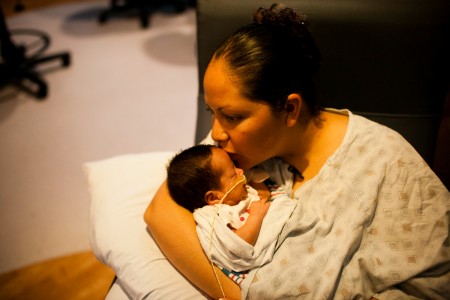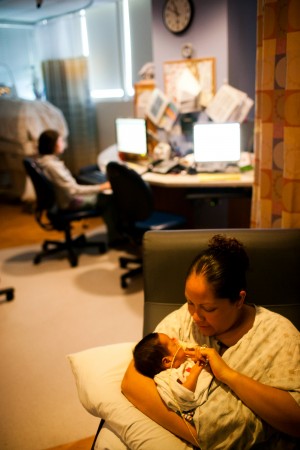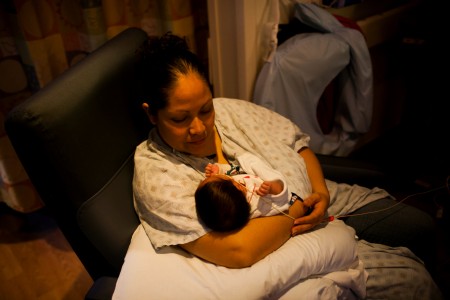CHOC Children’s is seeing fewer breast milk feeding errors after a more than two-year initiative to redesign the process for safer and more efficient handling.
With very few government regulations in place, hospitals across the country struggle to establish best practices in handling breast milk, and CHOC is no different. Busy nurses are often tasked with collecting, labeling, inventorying and distributing dozens of bottles during a shift, amidst other critical responsibilities.
“Our nurses are doing a multitude of highly important things, often being pulled in many directions at once,” said Caroline Steele, director of CHOC’s Clinical Nutrition & Lactation Services. “Without good support and a better system in place, there was potential for interruptions and errors.”
In June 2011, CHOC’s Joint Leadership Committee formed a process improvement team, including a physician co-chair and representatives from each inpatient nursing unit, Clinical Nutrition and Lactation, Quality and Transport. The team reviewed data from the previous 12 months and identified possible handling errors, such as storage problems, incorrect labels and instances of patients receiving the wrong milk.
Breast milk errors can spread diseases and infections and, in some cases, are reportable events to the California Department of Public Health. If the wrong milk is handed to a mother who then views a patient’s private information on the label, that event would be a reportable breach of the Healthcare Insurance Portability and Accountability Act (HIPAA) as well.
A New Method
In January 2013, the team moved milk preparation to a centralized location. The existing formula room was repurposed to accommodate both formula and breast milk preparation. Now referred to as the Nutrition Lab, it houses a breast milk freezer and a commercial dishwasher and is staffed with registered dietetic technicians. CHOC also operates a satellite nutrition lab in the CHOC Children’s Neonatal Intensive Care Unit (NICU) at St. Joseph Hospital.
CHOC then secured a $190,000 grant from UniHealth to purchase the Timeless™ Breast milk Tracking system. The software uses unique barcode identifiers to ensure babies are matched with the correct milk, and that the milk has not expired. The system launched in November 2013 in the NICU, medical and surgical units, neuroscience unit, oncology unit, pediatric intensive care unit (PICU) and cardiovascular intensive care unit (CVICU) at the hospital’s Orange campus.
Nurses previously fortified and prepared milk themselves at the bedside – a contamination risk – and then had to ask a second nurse to verify the accuracy of it at every step. That accuracy check is now done automatically.
“It used to take at least an hour to make your shift’s worth of milk,” NICU nurse Jenn Landman said. “That’s an hour you can spend with a baby’s family or do extra things, like bath time or a ‘spa day’ with a baby. It’s much more meaningful work.”
Now, when a mother checks in with her baby, a nurse prints labels for the breast milk expressed during their stay and scans the baby’s armband to verify the labels are correct. The mother attaches a label to a filled bottle, which is transferred to the Nutrition Lab for inventorying and storage. The lab’s technicians fortify the milk per doctor’s orders and deliver 12 hours worth of feedings back to the units twice a day.
All information about the milk is documented in the baby’s medical record.
In the first two months of the barcode program, 11,232 breast milk feedings were prepared by the Nutrition Lab, with 100 percent compliance to scanning in the lab and 97 percent compliance on the units.
“This gives moms that sense of security that human error has been taken out of the equation,” Landman said.
Next Steps
CHOC’s efforts have been noticed. The California Department of Public Health has commended the program and has asked Steele to train registered dietitian surveyors across the state on proper breast milk handling.
Meanwhile, plans are being made to implement the barcode system at CHOC Children’s at Mission Hospital, and the team hopes to purchase software to track formula, as well. They are seeking additional grant funding.
Starting this month, CHOC will also conduct a study that uses a new analyzer to identify the components of a mother’s milk, rather than assuming it contains generalized amounts of nutrients. That will make the fortification process more accurate, making sure babies are getting exactly what they need.
“We are always looking at ways that we can make our hospital safer and ultimately a better experience for the patient and family,” Steele said.








